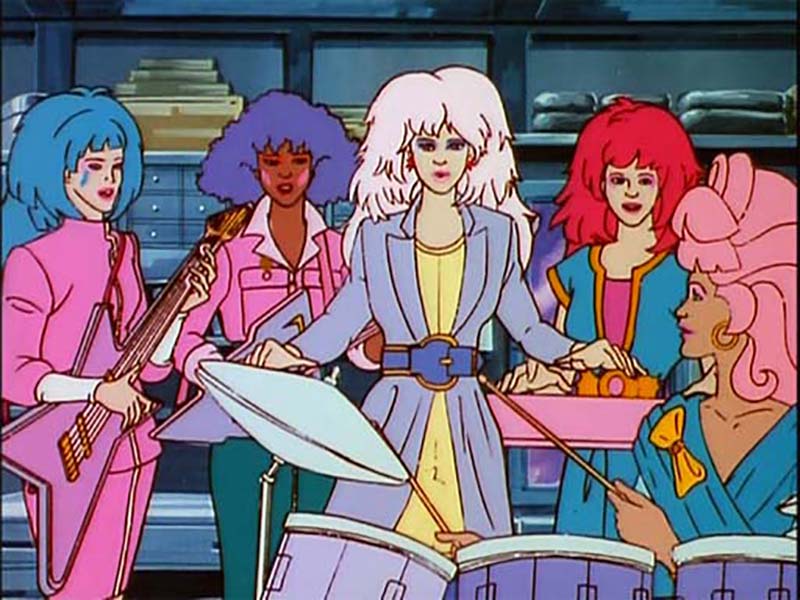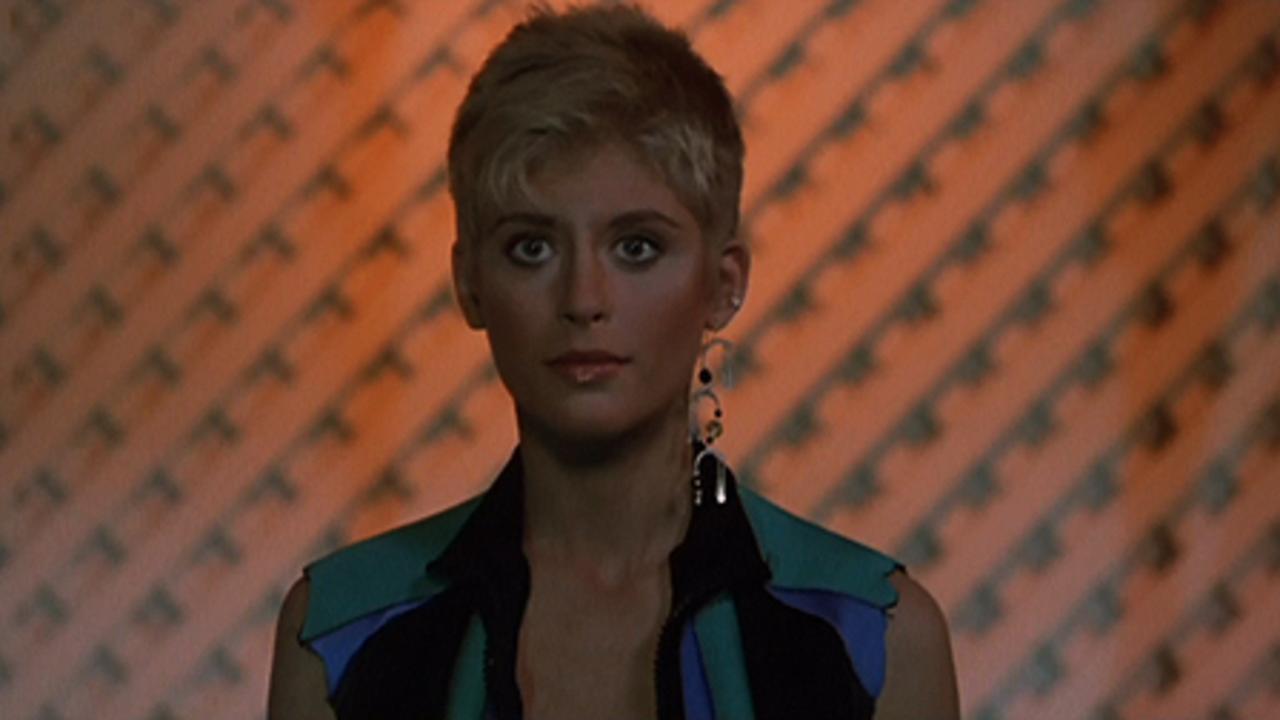This guest post written by Horrorella appears as part of our theme week on Ladies of the 1980s.
Jem and the Holograms was a pivotal part of my childhood. I watched it religiously. I couldn’t get enough of Jem and her rock star cohorts. The music, the characters, the stories – I ate it up like the candy-colored mountain of awesome that it was. I had a chance to revisit the series as an adult when I received the complete series box set as a birthday gift (note – it is SO gloriously pink). I poured some Cap’n Crunch cereal and sat down to revisit this show that had brought me so much joy in true Saturday Morning Cartoon fashion.
Reconnecting with this series was an incredibly fun experience, albeit a surprising one. I remembered Jem and her friends getting into scrapes, playing concerts, and trying to outwit the Misfits’ dastardly plans. I remembered the foster girls that found a home and a family at Starlight House and who were overseen by the band members. I remembered the conflict that Jem/Jerrica dealt with in keeping her true identity a secret from the world, and the resulting friction that created with her boyfriend Rio. I even remembered some of the songs.
[youtube_sc url=”https://www.youtube.com/watch?v=lkQE5wuBFeY”]
What I didn’t remember, and was pleasantly surprised by, was all of the diversity present in the show and the incredibly positive female role models that it presented to its young viewers. Though often criticized as being little more than a vehicle to promote the Hasbro line of dolls that had inspired the series, the show was actually so much more. It offered a positive statement on cultural acceptance and feminine strength at a time when children’s programming was lacking in both areas (and often still is today).
The Holograms celebrated an ethnically and culturally diverse group of characters who came from a variety of different backgrounds. Though Jerrica and Kimber were biological sisters, band members Aja (an Asian woman) and Shana (a Black woman) were adopted by the Benton family as children. Later, as the band expanded, a Latina drummer called Raya was added to the mix. This theme went on to include the foster girls populating Starlight House. Ba Nee, for example, a little girl involved in several major plot threads throughout the series, had been born to a Vietnamese woman and an American soldier before immigrating to the United States. The series took the time to showcase these cultural and ethnic differences, highlighting different traditions and backgrounds while also bringing the characters together as a united family.
Series creator Christy Marx stated in an interview with Off Hollywood that ethnic diversity was important to her when developing the characters. She wanted to be sure that all girls watching the show had someone to identify with, and made that a core goal as she began to develop the expanded cast. This was definitely a rarity among 1980s animated programming, and is something that made Jem and the Holograms stand out among its contemporaries.
Juxtaposed with our heroes, we have The Misfits – the nemesis band of the Holograms who are constantly trying to derail any project our heroes might be working on in order to stay on top. They are comprised fully of white women, and the leader, Pizzazz, comes from a particularly privileged background. Raised in an affluent lifestyle, spoiled, constantly angry, and dedicated to nothing more than getting her way by any means necessary, Pizzazz is the embodiment of entitlement. She will do anything within her power to stay on top.
[youtube_sc url=”https://www.youtube.com/watch?v=7r6-Ie0un84″]
In many ways, The Misfits represent the privileged status quo. They came to stardom before the Holograms, and are determined not to give up their spot on top. They refuse to make way or share that space with anyone else. They demand a level of treatment they feel is in keeping with their status as rockstars, and care little for anyone besides themselves (Stormer is often the exception to this rule, as she proves early on to have a heart, yet is easily bullied and influenced by her bandmates). The Misfits are simply another example of the people in power remaining in power, while everyone else has to struggle to get by.
Conversely, the Holograms can be seen to embody a more ideal future; something to strive for. Inclusive, and aiming not for fame and fortune, but for acceptance, integrity, and the greater good. Their songs have meaning and a positive message, often focusing on teamwork, fair play and the like. They lead by example, and offer a blueprint for what we could be, rather than what we often are.

The feminism and the female empowerment in the series is also incredibly meaningful and noteworthy. Jerrica/Jem is an icon, both within the story and for the show’s legions of young fans. Not for her fame or for being the rockstar with the cool clothes and the pink hair (though, admittedly, the pink hair was pretty rad), but for being a successful, confident and capable woman. She was a different kind of role model for a little girl growing up in the 1980s. We tend to focus on the fashion and the music present in the show, but more importantly, Jem gave us a powerful and successful female character to look up to. In her, we found a character who was in charge of her own destiny. An intelligent, savvy business woman who maintained not only a record company, but a nonprofit that housed, cared for, and provided a supportive home for foster children. In Jerrica, we see a balance of a woman who is able to achieve professional, financial, and artistic success, while also contributing positively and meaningfully to the world around her.
“The thing I like about Jem and Jerrica is that she’s kick ass in how she cares about this entire household full of foster girls, or she’s kick ass because she has this musical career, or she’s a music executive. She’s someone who is strong and independent and directs her own life.”
Marx also notes that though the series, its fashion, and its technology are all very 80s, the stories still speak to us even today. They have a timelessness to them that allows them to carry on. And as much as last year’s film revival was a raging disaster, the silver lining is that the values and power of the property have found a new embodiment reaching a new generation in the form of the IDW’s comic series. The books take the characters, stories, and concepts that made the original series so important and meaningful and bring them forward into the modern era, with continued racial diversity, varied body types, and sexual orientations; a swath of powerful, well-developed female characters and new adventures.
Jem and the Holograms impacted its fan base in a way that few series of the time (or since) were able to. Through building a cast and a series of stories that reflected the people watching it, it connected with its audience in an entirely new way. It provided the viewers with a positive female role model who was strong and powerful in ways not typically seen on television, and certainly not in children’s programming. Jem and the Holograms influenced a generation, and the lessons we learned from that show and its stories were taken with us into adulthood. Hopefully, its new incarnation will continue to do the same for new legions of fans.
See also at Bitch Flicks: Was ‘Jem and the Holograms’ a Good Show for Little Girls?
Horrorella has written about film for Ain’t it Cool News, the Women in Horror Annual and on her blog at horrorella.com. She geeks out incessantly over movies, television, comics and kitties. You can gab with her on Twitter @horrorellablog.









